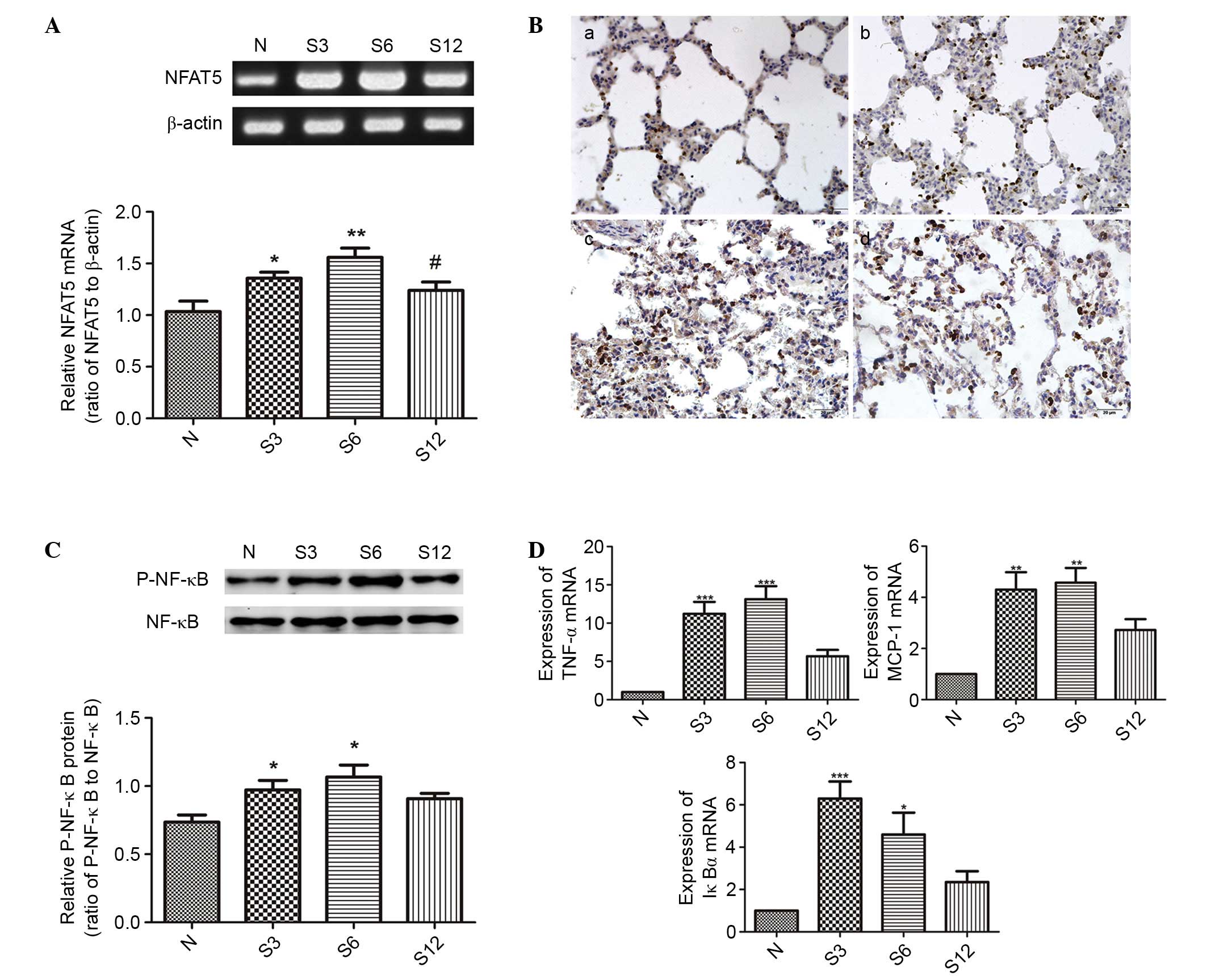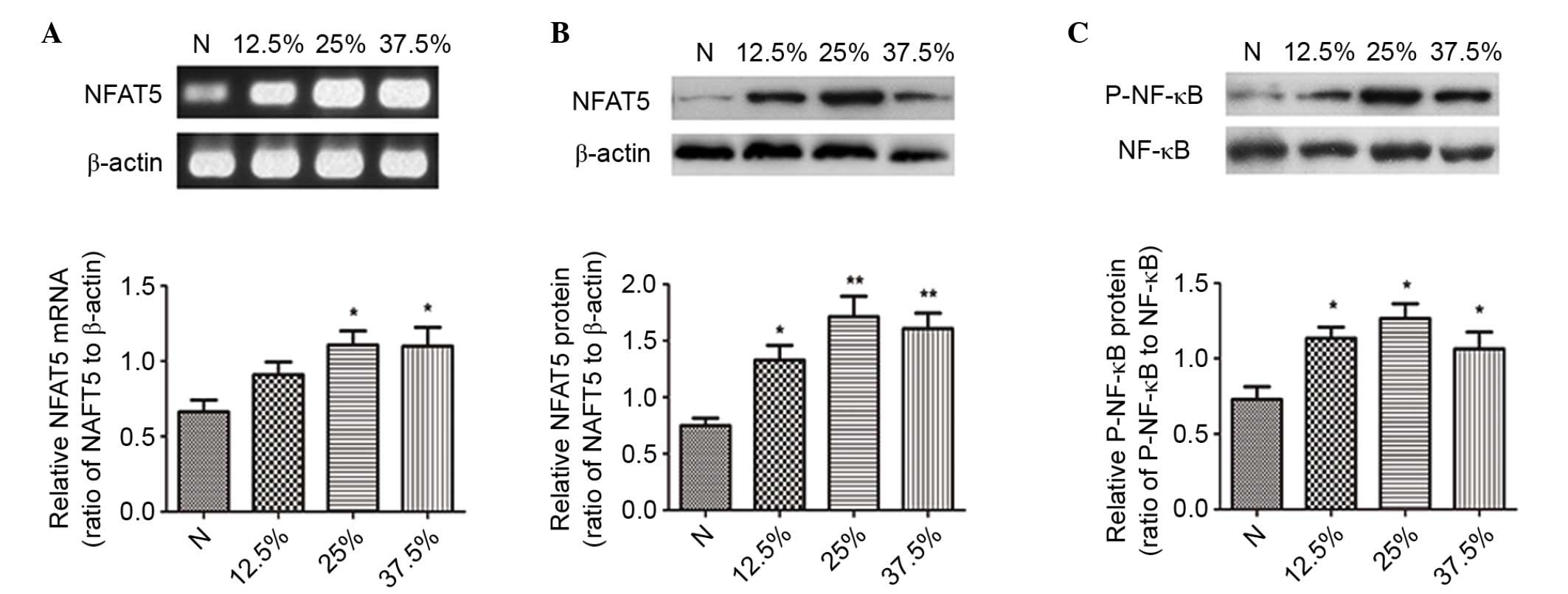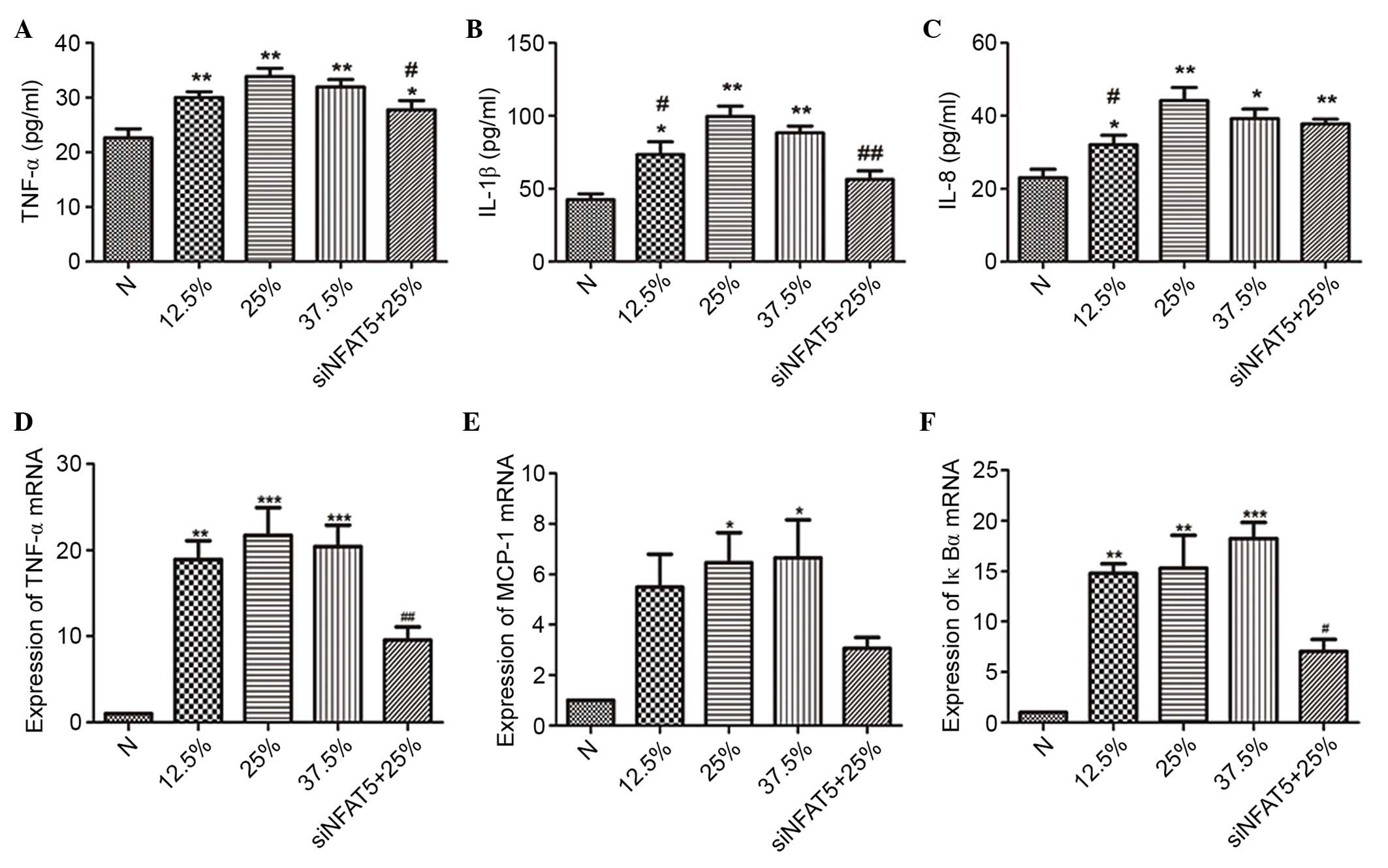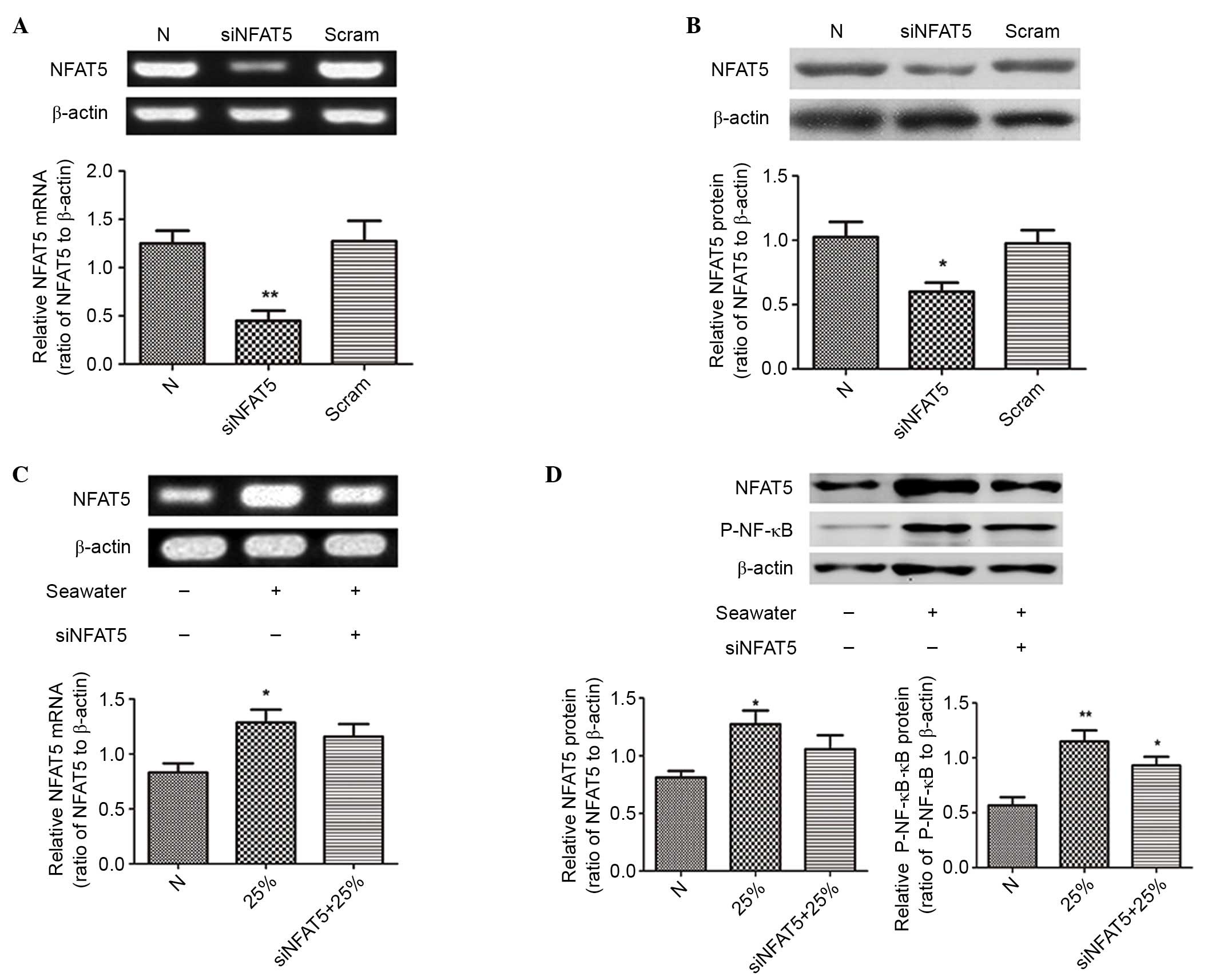NFAT5 participates in seawater inhalation‑induced acute lung injury via modulation of NF-κB activity
- Authors:
- Published online on: October 19, 2016 https://doi.org/10.3892/mmr.2016.5860
- Pages: 5033-5040
-
Copyright: © Li et al. This is an open access article distributed under the terms of Creative Commons Attribution License.
Abstract
Introduction
Acute lung injury (ALI) and acute respiratory distress syndrome (ARDS) remain leading causes for morbidity and mortality in critically ill patients (1,2). According to data from Acute Lung Injury Verification of Epidemiology, ALI/ARDS affects approximately 7% of patients in intensive care units, and approximately 54% of those develop ARDS within 24 h (3). Similar to stress situations such as trauma, burns and sepsis, seawater aspiration can induce ALI/ARDS, with hypoxemia being the major pathophysiological change that occurs. Furthermore, lung edema is prominent in seawater exposure-induced lung injury, as highly osmotic and alkaline seawater can force water to leave the blood vessels and flood into the alveolar spaces (4). Progress has been made, however, there remains a requirement to investigate the underlying pathophysiological mechanisms of seawater aspiration-induced ALI, in order to improve the prevention and treatment of this condition.
Nuclear factor of activated T cells 5 (NFAT5), also termed osmotic-response element binding protein (OREBP) or tonicity-responsive enhancer binding protein (TonEBP), is a member of the NFAT family of transcription factors (5). When NFAT5 is activated by high NaCl and other hypertonic stresses, it increases transcription of osmoprotective genes, including those involved in increased expression of organic osmolytes (6) and heat shock proteins (7–9). Several mechanisms contribute to hypertonicity-induced activation of TonEBP/OREBP, including its translocation from the cytoplasm to nucleus (10,11), transactivation (12), and increased TonEBP/OREBP protein expression (11). In the kidney, NFAT5 additionally controls expression of a urea transporter (UT-A) (13) and of aquaporin-2 (6,7), thus regulating the mechanisms of urinary concentration. NFAT5 has been previously observed to be expressed in the majority of tissue types, suggesting that the function of NFAT5 is not limited to the renal medulla. Several additional genes regulated by NFAT5 that are not directly involved in cellular osmoadaptation have additionally been identified (14). These include genes involved in embryogenesis and development, tumor metastasis and hepatic detoxification enzymes, suggesting biological importance of NFAT5 that is distinct from osmoadaptation (14). However, it remains unclear whether NFAT5 serves a pathophysiological role in seawater aspiration-induced ALI.
Materials and methods
Drugs and reagents
Monoclonal anti-NFAT5 (cat. no. ab3446) and monoclonal β-actin (cat. no. ab8226) antibodies were purchased from Abcam (Cambridge, UK). Anti-phosphorylated (P)-nuclear factor (NF)-κB p65 (cat. no. 8242) and anti-NF-κB p65 (cat. no. 3033) monoclonal antibodies were obtained from Cell Signaling Technology, Inc. (Danvers, MA, USA). Enzyme-linked immunosorbent assay (ELISA) kits for tumor necrosis factor (TNF)-α, interleukin (IL)-1β and IL-8 were purchased from (R&D Systems, Inc., Minneapolis, MN, USA). TurboFect transfection reagent was obtained from Thermo Fisher Scientific, Inc. (Waltham, MA, USA). Seawater (osmolality 1300 mmol/l, pH 8.2, specific weight 1.05, NaCl2 6.518 g/l, MgSO4 3.305 g/l, MgCl2 2.447 g/l, CaCl2 1.141 g/l, KCl 0.725 g/l, NaHCO3 0.202 g/l and NaBr 0.083 g/l) was prepared according to the major composition of the East China Sea provided by the Chinese Ocean Bureau. All the other chemical reagents were obtained from Sigma-Aldrich (Merck Millipore, Darmstadt, Germany).
Animals and procedures
Adult male Sprague-Dawley rats (200–250 g weight; 9 weeks old; n=48) were obtained from the animal center of the Fourth Military Medical University (Xi'an, China). Rats were maintained in a temperature-controlled house with 12-h light-dark cycles. All experiments were approved by the Animal Care and Use Committee of the Fourth Military Medical University and were in accordance with the Declaration of the National Institutes of Health Guide for Care and Use of Laboratory Animals.
All rats were randomly divided into the following 4 groups: i) Control group (N, n=12), rats were anesthetized with 1.5% sodium pentobarbital (50 mg/kg; Sigma-Aldrich; Merck Millipore) and followed by a sham operation; ii) seawater aspiration 3 h group (S3, n=12), rats were anesthetized with 1.5% sodium pentobarbital followed by intratracheal administration of seawater (4 ml/kg body weight) into both lungs via a 20-gauge intravenous catheter through the tracheae over 4 min, rats were maintained in a supine position and 30° head-up tilt during the experiments and were euthanized at 3 h; iii) seawater aspiration 6 h group (n=12), rats received seawater aspiration as for the S3 group, and were euthanized at 6 h; and iv) seawater aspiration 12 h group (n=12), rats received seawater aspiration as for the S3 group, and rats were euthanized at 12 h. Euthanasia was conducted with a pentobarbital overdose at the time points indicated, then the lungs were harvested for the experiments described below.
Arterial blood gas analysis
Subsequent to seawater administration, a PE-50 catheter was inserted in the right carotid artery to obtain blood samples. Arterial blood gas analysis was performed at 3, 6 and 12 h subsequent to seawater aspiration, respectively.
Lung wet-to-dry (W/D) weight ratio
Subsequent to removal of the trachea by blunt dissection, the right lungs (n=6) were weighed immediately (wet weight). Subsequently, the lungs were dried to a constant weight at 50°C for 72 h and weighed again (dry weight). The ratios of lung wet-to-dry weight were calculated to evaluate the severity of pulmonary edema.
Histopathological evaluation
At the end of experiments, the lung tissues of the lower right lung of each rat (n=6) were fixed with 10% formalin for 24 h. Subsequent to fixation, the tissues were embedded in paraffin and cut into 5 µm sections, and then stained with hematoxylin-eosin. Microscopic evaluation was performed to characterize lung injury.
Immunohistochemistry assessment of NFAT5 in rat lungs
To investigate the expression level of NFAT5, the lung tissue harvested previously was embedded in paraffin and cut into 5-µm sections. Subsequent to dewaxing, rehydration and antigen retrieval, the sections were stained with the anti-NFAT5 antibody (1:100) following a standard procedure (15). Staining was detected using 3,3′-diaminobenzidine and observed under a light microscope.
Preparation of bronchoalveolar lavage fluid (BALF)
BALF was performed using 3 ml ice-cold phosphate-buffered saline three times) in all groups. In each rat, 90% (2.7 ml) of the total injected volume was consistently recovered. Subsequently, BALF was centrifuged at 520 × g for 20 min at 4°C, then the supernatant was stored at −70°C for subsequent use.
NR8383 cell culture
The alveolar macrophage cell line, NR8383, was maintained in Ham's F12 medium supplemented with 10% fetal calf serum, 100 U/ml penicillin and 100 µg/ml streptomycin at 37°C in a humidified atmosphere containing 5% CO2 and 95% air. Different volume ratios of seawater (12.5, 25 and 37.5%) were prepared by adding seawater into the medium immediately prior to use. The cells and supernatant were harvested at 6 h subsequent to exposure to seawater.
Small interfering RNA (siRNA) transfection
The primer sequences of the NFAT5 siRNA were 5′-GCAGCAGUCUCCUCUUUAUTT-3′ and 5′-AUAAAGUGGAGACUGCUGCTT-3′. The primers sequences of the negative control were 5′-UUCUCCGAACGUGUCACGUTT-3′ and 5′-ACGUGACACGUUCGGAGAATT −3′. The NFAT5 siRNA and negative control siRNA were transfected into NR8383 cells using TurboFect transfection reagent according to the manufacturer's instructions.
ELISA
Levels of TNF-α, IL-1 and IL-8 in BALF and the cell supernatants were determined using the commercially available ELISA kits according to the manufacturer's instructions.
Reverse transcription-polymerase chain reaction (RT-PCR)
Total RNA were isolated from lung tissues or NR8383 cells homogenate using TRIzol (Takara Bio, Inc., Otsu, Japan). Samples with a 260:280 nm absorbance ratio of 1.9 or greater were used for subsequent reverse transcription using PrimeScript RT reagent kit (Takara Bio, Inc.). The sequences of the rat NFAT5 primers were 5′-CGACAGTGCCAAAGCACCTC-3′ (forward) and 5′-AACCGGATACTGTCCACACAACATA-3′ (reverse). The sequences of the rat β-actin primers were 5′-GCACTGTGTTGGCATAGAGGTC-3′ (forward) and 5′-ACGGTCAGGTCATCACTATCGG-3′ (reverse). SYBR Premix Ex Taq II (TaKaRa Bio Inc.) and 50 µg cDNA were used for PCR. The PCR reaction conditions for NFAT5 were as follows: 2 min initial denaturation procedure at 94°C, followed by 35 cycles of 94°C for 45 sec, 62°C for 45 sec and 72°C for 1 min, and a final extension step at 72°C for 8 min. The PCR products were analyzed by agarose gel electrophoresis. An invariant mRNA quantity of β-actin was used as an internal control to quantify PCR products.
In addition, the mRNA expression levels of three NF-κB-dependent genes [TNF-α, monocyte chemoattractant protein 1 (MCP-1) and inhibitor of κB (IκBα)] were detected in order to reveal the changes of NF-κB activation by RT-quantitative PCR (RT-qPCR) analysis, as previously described (16). The sequences of the rat TNF-α primers were 5′-TGAACTTCGGGGTGATCG−3′ (forward) and 5′-GGGCTTGTCACTCGAGTTTT-3′ (reverse). The sequences of the rat MCP-1 primers were 5′-AGCATCCACGTGCTGTCTC-3′ (forward) and 5′-GATCATCTTGCCAGTGAATGAG-3′ (reverse). The sequences of the rat IκBα primers were 5′-CTGGCCAGTGTAGCAGTCTT-3′ (forward) and 5′-GTCACCAAGTGCTCCACGAT-3′ (reverse).
Western blot analysis
Total proteins from lung tissues or NR8383 cells were extracted as previously reported (17). Protein concentrations were determined using the coomassie brilliant blue assay. Samples were separated on a denaturing 12% SDS-polyacrylamide gel and transferred to a nitrocellulose membrane followed by incubation with the primary antibodies for NFAT5 (1:500), P-NF-κB p65 (1:500), NF-κB p65 (1:500) and β-actin (1:8,000). Immunoreactivity was visualized with the corresponding peroxidase-conjugated secondary antibody (cat. no. ab6721; Abcam); the relative content of target proteins was detected by chemiluminescence using Chemiluminescent HRP Substrate (EMD Millipore, Billerica, MA, USA).
Statistical analysis
Data are expressed as the mean ± standard error, and statistical analysis was performed with a one-way analysis of variance, followed by a Tukey test for multiple comparisons. P<0.05 was considered to indicate a statistically significant difference.
Results
Seawater inhalation induced severe ALI and increased inflammatory cytokines in rats
As presented in Table I, seawater aspiration markedly reduced PaO2, and an clear increase in PaCO2 was observed at 3 and 6 h, which was partially reduced at 12 h. We next observed the pulmonary histological alterations at 3, 6 and 12 h subsequent to seawater inhalation by microscopy. The pulmonary tissue structure and alveoli were observed to be normal in the control group (Fig. 1A). Seawater inhalation time-dependently resulted in pulmonary edema, infiltration of inflammatory cells and alveolar damage (Fig. 1B-D).
The lung W/D weight ratios was an index of lung edema, and is presented in Fig. 2. Subsequent to seawater inhalation, the W/D weight ratios were significantly increased compared with that of the control group at 3 and 6 h (P<0.01). However, seawater inhalation did not increase the W/D weight ratios of the 12 h group.
Regarding the inflammatory cytokines, TNF-α, IL-1β and IL-8 in BALF were only minimally expressed in the control groups, as presented in Fig. 3. Subsequent to seawater administration, the content of TNF-α, IL-1β and IL-8 were significantly increased at 3 and 6 h.
Seawater inhalation enhanced the expression of NFAT5 and the activation of NF-κB in rats
Subsequent to seawater inhalation, the mRNA expression of NFAT5 was markedly increased at different time points (P<0.05; Fig. 4A), and the immunohistochemical assessment of NFAT5 expression confirmed the results above (Fig. 4B).
In addition, the expression of P-NF-κB was also significantly increased at 3 and 6 h (P<0.05; Fig. 4C). In addition, the transcription of three NF-κB-dependent genes (TNF-α, MCP-1 and IκBα) was detected in order to assess the changes to NF-κB activation. As presented in Fig. 4D, the NF-κB activity increased 4- to 10-fold following 6 h of seawater challenge, which corresponded to the phosphorylation of NF-κB.
Different levels of seawater increased the expression of NFAT5 and the activation of NF-κB in NR8383 cells
Subsequently, the effects of different concentrations of seawater on NR8383 cells were assessed. The results demonstrated that seawater concentration-dependently promoted the mRNA and protein expression levels of NFAT5 (Fig. 5A and B).
The activation of NF-κB was significantly increased at the different concentrations (Fig. 5C). The mRNA expression of all three NF-κB-dependent genes (TNF-α, MCP-1 and IκBα) further confirmed the stimulatory effect of seawater on the NF-κB pathway (Fig. 6D-F).
siNFAT5 reduced the expression of NFAT5 and the activation of NF-κB in NR8383 cells
The siRNA of NFAT5 (siNFAT5) was used to downregulate NFAT5 expression in NR8383 cells. Results demonstrated that siNFAT5 significantly reduced the mRNA and protein expression levels of NFAT5 induced by 25% of seawater exposure in NR8383 cells, and the negative control sequences had no effect (P<0.05; Fig. 7). In addition, the activation of NF-κB was significantly blocked, as presented in Figs. 7D and 6D-F.
siNFAT5 reduced the levels of inflammatory cytokines in NR8383 cells
Different concentrations of seawater markedly increased the levels of TNF-α, IL-1β and IL-8 in the NR8383 cell supernatants, while siNFAT5 markedly reduced the content of TNF-α, IL-1β and IL-8 induced by seawater exposure (Fig. 6).
Discussion
In the present study, it was demonstrated that NFAT5 serves an important pathophysiological role in seawater aspiration-induced ALI. Seawater aspiration impaired arterial blood gas in a short time with a significant reduction in the partial pressure of O2 and an increase in that of CO2. In addition, clear pulmonary edema and vascular leakage were induced. Furthermore, seawater exposure induced the mRNA and protein expression of NFAT5 and the activation of NF-κB in lung tissues and NR8383 cells. Using the siRNA of NFAT5, the mRNA and protein expression levels of NFAT5 and the activation of NF-κB were markedly reduced, accompanied by the reduction of certain inflammatory cytokines.
Seawater is a hyperosmolar fluid and its NaCl concentration is 3–3.5%, approximately 3-fold of that of physiological saline (18), which, when drawn into lung tissues, may induce serious complications, characterized by infiltration of inflammatory cells and changes to the permeability of the alveolar wall (19). However, the precise mechanisms of seawater aspiration-induced ALI remain unclear. Previous studies have demonstrated that the NF-κB pathway serves a key role in the pathogenesis of ALI/ARDS. Stimulated with lipopolysaccharides, NF-κB is activated by phosphorylation, enters the nucleus and regulates the expression of inflammatory cytokines, therefore, the control of NF-κB activation is crucial for the treatment of inflammation (20,21).
NFAT5 is the most recently described member of the Rel family of transcription factors, which includes NF-κB and NFAT1-4, which serve central roles in inducible gene expression during the immune response (22). NFAT5 was initially described to drive osmoprotective gene expression in renal medullary cells, which are routinely exposed to high extracellular osmolalities. It has been previously reported that local or systemic hyperosmolality is evident during the course of various inflammatory disorders, accordingly, in mononuclear cells and epithelial cells, NFAT5 stimulates the expression of various pro-inflammatory cytokines during elevated ambient tonicity (14). Thus, it is hypothesized that NFAT5 serves a significant role in the initiation and progression of the inflammatory disease process (23). However, whether NFAT5 participates in the development of seawater aspiration-induced ALI and what the role of NFAT5 is in this process remain to be fully elucidated.
It has been reported that NFAT5 can participate in the adaption to hypertonicity by enhancing NF-κB activity (16). High levels of NFAT5 expression can enhance the NF-κB activation (16), and low levels of NFAT5 expression can reduce NF-κB activation, although it has no effect on p65 nuclear translocation (16). Based on these previous data, it was suggested that the stimulatory effect derived from hypertonicity on NF-κB is dependent, at least in part, on NFAT5 expression. The results additionally demonstrated that NFAT5 was responsible for the inflammatory responses resulting from seawater aspiration through affecting the activity of NF-κB. Subsequent to seawater exposure, the mRNA and protein expression levels of NFAT5 both in lung tissues and in NR8383 cells were increased, accompanied by the activation of NF-κB and the aggregation of inflammatory cytokines. Using NFAT5 siRNA, it was identified that inhibition of NFAT5 reduced seawater aspiration-induced activation of NF-κB and inflammatory cytokines.
In conclusion, the results of the present study suggest that NFAT5 serves an important pathophysiological role in seawater aspiration-induced ALI. Seawater inhalation increases the mRNA and protein expression levels of NFAT5 and the activation of P-NF-κB, lung tissues and in NR8383 cells. With the addition of the siRNA of NFAT5, the mRNA and protein expression of NFAT5 and the activation of NF-κB were markedly reduced, accompanied by the reduction of inflammatory cytokines. Although the mechanisms of NFAT5 on seawater aspiration-induced ALI require further investigation, the present study partially explained the importance of NFAT5 for ALI/ARDS.
Acknowledgements
The current study was supported by the National Natural Science Foundation of China (grant nos. 81270124, 81270328, 81372129 and 30901752).
References
|
Costa EL, Schettino IA and Schettino GP: The lung in sepsis: Guilty or innocent? Endocr Metab Immune Disord Drug Targets. 6:213–216. 2006. View Article : Google Scholar : PubMed/NCBI | |
|
Frutos-Vivar F, Ferguson ND and Esteban A: Epidemiology of acute lung injury and acute respiratory distress syndrome. Semin Respir Crit Care Med. 27:327–336. 2006. View Article : Google Scholar : PubMed/NCBI | |
|
Angus DC, Linde-Zwirble WT, Lidicker J, Clermont G, Carcillo J and Pinsky MR: Epidemiology of severe sepsis in the United States: Analysis of incidence, outcome, and associated costs of care. Crit Care Med. 29:1303–1310. 2001. View Article : Google Scholar : PubMed/NCBI | |
|
Salomez F and Vincent JL: Drowning: A review of epidemiology, pathophysiology, treatment and prevention. Resuscitation. 63:261–268. 2004. View Article : Google Scholar : PubMed/NCBI | |
|
Lopez-Rodriguez C, Aramburu J, Rakeman AS and Rao A: NFAT5, a constitutively nuclear NFAT protein that does not cooperate with Fos and Jun. Proc Natl Acad Sci USA. 96:7214–7219. 1999. View Article : Google Scholar : PubMed/NCBI | |
|
Lam AK, Ko BC, Tam S, Morris R, Yang JY, Chung SK and Chung SS: Osmotic response element-binding protein (OREBP) is an essential regulator of the urine concentrating mechanism. J Biol Chem. 279:48048–48054. 2004. View Article : Google Scholar : PubMed/NCBI | |
|
Lopez-Rodriguez C, Antos CL, Shelton JM, Richardson JA, Lin F, Novobrantseva TI, Bronson RT, Igarashi P, Rao A and Olson EN: Loss of NFAT5 results in renal atrophy and lack of tonicity-responsive gene expression. Proc Natl Acad Sci USA. 101:2392–2397. 2004. View Article : Google Scholar : PubMed/NCBI | |
|
Na KY, Woo SK, Lee SD and Kwon HM: Silencing of TonEBP/NFAT5 transcriptional activator by RNA interference. J Am Soc Nephrol. 14:283–288. 2003. View Article : Google Scholar : PubMed/NCBI | |
|
Woo SK, Lee SD, Na KY, Park WK and Kwon HM: TonEBP/NFAT5 stimulates transcription of HSP70 in response to hypertonicity. Mol Cell Biol. 22:5753–5760. 2002. View Article : Google Scholar : PubMed/NCBI | |
|
Ko BC, Turck CW, Lee KW, Yang Y and Chung SS: Purification, identification, and characterization of an osmotic response element binding protein. Biochem Biophys Res Commun. 270:52–61. 2000. View Article : Google Scholar : PubMed/NCBI | |
|
Miyakawa H, Woo SK, Dahl SC, Handler JS and Kwon HM: Tonicity-responsive enhancer binding protein, a rel-like protein that stimulates transcription in response to hypertonicity. Proc Natl Acad Sci USA. 96:2538–2542. 1999. View Article : Google Scholar : PubMed/NCBI | |
|
Ferraris JD, Williams CK, Persaud P, Zhang Z, Chen Y and Burg MB: Activity of the TonEBP/OREBP transactivation domain varies directly with extracellular NaCl concentration. Proc Natl Acad Sci USA. 99:739–744. 2002. View Article : Google Scholar : PubMed/NCBI | |
|
Nakayama Y, Peng T, Sands JM and Bagnasco SM: The TonE/TonEBP pathway mediates tonicity-responsive regulation of UT-A urea transporter expression. J Biol Chem. 275:38275–38280. 2000. View Article : Google Scholar : PubMed/NCBI | |
|
Neuhofer W: Role of NFAT5 in inflammatory disorders associated with osmotic stress. Curr Genomics. 11:584–590. 2010. View Article : Google Scholar : PubMed/NCBI | |
|
Liu W, Dong M, Bo L, Li C, Liu Q, Li Y, Ma L, Xie Y, Fu E, Mu D, et al: Epigallocatechin-3-gallate ameliorates seawater aspiration-induced acute lung injury via regulating inflammatory cytokines and inhibiting JAK/STAT1 pathway in rats. Mediators Inflamm. 2014:6125932014. View Article : Google Scholar : PubMed/NCBI | |
|
Roth I, Leroy V, Kwon HM, Martin PY, Féraille E and Hasler U: Osmoprotective transcription factor NFAT5/TonEBP modulates nuclear factor-kappaB activity. Mol Biol Cell. 21:3459–3474. 2010. View Article : Google Scholar : PubMed/NCBI | |
|
Li C, Bo L, Liu Q, Liu W, Chen X, Xu D and Jin F: Activation of TRPV1-dependent calcium oscillation exacerbates seawater inhalation-induced acute lung injury. Mol Med Rep. 13:1989–1998. 2016.PubMed/NCBI | |
|
Suresh R, Kupfer Y and Tessler S: Acute respiratory distress syndrome. N Engl J Med. 343:660–661. 2000. View Article : Google Scholar : PubMed/NCBI | |
|
Gregorakos L, Markou N, Psalida V, Kanakaki M, Alexopoulou A, Sotiriou E, Damianos A and Myrianthefs P: Near-drowning: Clinical course of lung injury in adults. Lung. 187:93–97. 2009. View Article : Google Scholar : PubMed/NCBI | |
|
Abraham E: NF-kappaB activation. Crit Care Med. 28:(Suppl 4). N100–N104. 2000. View Article : Google Scholar : PubMed/NCBI | |
|
Blackwell TS and Christman JW: The role of nuclear factor-kappa B in cytokine gene regulation. Am J Respir Cell Mol Biol. 17:3–9. 1997. View Article : Google Scholar : PubMed/NCBI | |
|
Aramburu J, Drews-Elger K, Estrada-Gelonch A, Minguillón J, Morancho B, Santiago V and López-Rodriguez C: Regulation of the hypertonic stress response and other cellular functions by the Rel-like transcription factor NFAT5. Biochem Pharmacol. 72:1597–1604. 2006. View Article : Google Scholar : PubMed/NCBI | |
|
Halterman JA, Kwon HM and Wamhoff BR: Tonicity-independent regulation of the osmosensitive transcription factor TonEBP (NFAT5). Am J Physiol Cell Physiol. 302:C1–C8. 2012. View Article : Google Scholar : PubMed/NCBI |
















